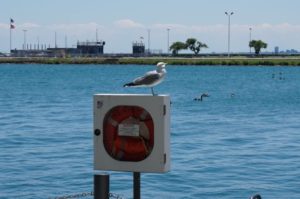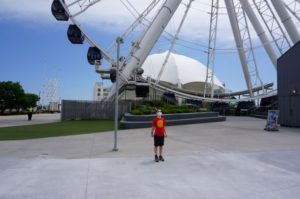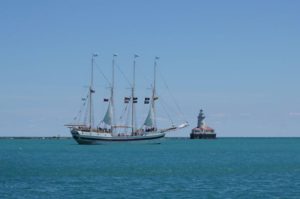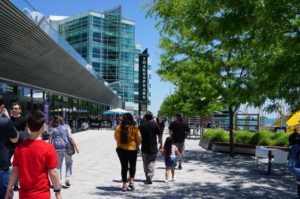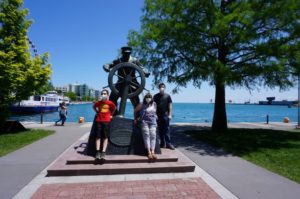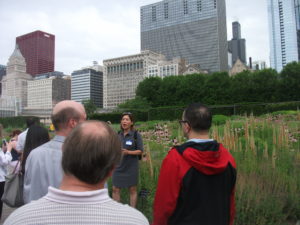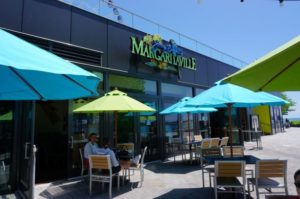 People in the Chicago area, and many beyond, some well beyond, are familiar with the city’s decades-old Taste of Chicago, featuring booths in Grant Park from dozens of the city’s iconic restaurants. Wandering the closed streets within the park, you can get pizza, jerk chicken, Indian foods, and a wide variety of other edibles while listening to entertainment and enjoying the sun, as long as the weather holds. The event has spawned numerous imitators throughout the suburbs, such as Taste of Aurora and Taste of Evanston.
People in the Chicago area, and many beyond, some well beyond, are familiar with the city’s decades-old Taste of Chicago, featuring booths in Grant Park from dozens of the city’s iconic restaurants. Wandering the closed streets within the park, you can get pizza, jerk chicken, Indian foods, and a wide variety of other edibles while listening to entertainment and enjoying the sun, as long as the weather holds. The event has spawned numerous imitators throughout the suburbs, such as Taste of Aurora and Taste of Evanston.
But not this year. Big festivals are out, social distancing is in, masks are de rigueur, and the restaurants offer take-out or delivery, if anything. Some are now adapting to offering outside dining when weather permits, but indoor dining must await the next phase of reopening, not only in Chicago but throughout Illinois. Blame coronavirus, but please don’t try to tell us it’s a hoax, or that you can cure it with hydroxychloroquine, or that distancing doesn’t matter. Here in Chicago, we can read the numbers and follow the logic, and we know better. Someone else can drink the Clorox, or the Kool-Aid, or whatever. The vast majority of us prefer to stay safe. And yes, we are aware that the demonstrations for racial justice may produce an uptick in cases. On the other hand, we know that the issue of police reform has been brewing for a long time, and people are impatient. It is not hypocritical to insist that reform is overdue after the death of George Floyd.
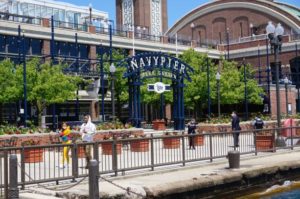 Within the past week in Chicago, a few things reopened, cautiously. Navy Pier, which competes with Millennium Park as the city’s leading tourist attraction, now offers outdoor dining but does not yet allow tourists to wander the stores inside the complex. That is okay; caution is in order. We do not need to follow the practice of some states that either never instituted a stay-at-home order (like neighboring Iowa) or reversed one with a highly partisan state Supreme Court decision (Wisconsin, you’re not helping!). Unlike, say, Alabama and Georgia, Illinois’s numbers of COVID cases and deaths have been declining. It would be nice to keep it that way.
Within the past week in Chicago, a few things reopened, cautiously. Navy Pier, which competes with Millennium Park as the city’s leading tourist attraction, now offers outdoor dining but does not yet allow tourists to wander the stores inside the complex. That is okay; caution is in order. We do not need to follow the practice of some states that either never instituted a stay-at-home order (like neighboring Iowa) or reversed one with a highly partisan state Supreme Court decision (Wisconsin, you’re not helping!). Unlike, say, Alabama and Georgia, Illinois’s numbers of COVID cases and deaths have been declining. It would be nice to keep it that way.
My wife and I reached our 35th anniversary on June 8. Occasionally, we’ve celebrated elsewhere (Honolulu, or Charleston, SC), but usually we’ve eaten out in Chicago, attended the Blues Fest, or done something else that was fun. This year, we had a few too many distractions just before the actual date (like getting the air conditioning fixed), so we chose to wait until Saturday, June 13, for a delayed event. We chose to investigate Navy Pier and enjoy a leisurely outdoor lunch instead, accompanied by two grandsons, Angel, 16, and Alex, 11. The outdoor tables at Jimmy Buffett’s Margaritaville seat four anyway. We decided to get a Taste of Reopening.
Did I mention gusty? Shortly after we were seated and the waiter had brought four large plastic cups of water, the wind caught my wife by surprise and knocked over her water. It spread across the entire table, soaking the paper menus and dripping onto both my lap and Alex’s. We hurriedly sought the waiter’s help and used paper towels to wipe up the mess as fast as possible. Fortunately, we had all chosen our orders, so we could dispose of the menus and laugh at the absurdity of it all. You can’t get angry with the wind. Besides, what is summer for? Roll with the punches.
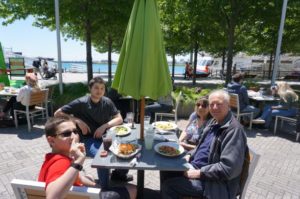 Restaurants have all struggled with the restrictions, but I must commend the generosity of our hosts. Once the waiter shot photos of us after learning of our anniversary. (He mentioned his own mother celebrated a birthday on June 9). He also ensured that the manager complimented us with a $15 reduction of our bill. When we all ordered key lime pie for dessert, he brought a fifth slice as an anniversary bonus. They were doing all they could to help us celebrate within the limitations of the tentative reopening, and they clearly appreciated our patronage. My order of teriyaki shrimp and chicken, accompanied by broccoli and rice with a slice of teriyaki pineapple, was delicious. My wife and our grandsons made other choices, but no one complained. (Yes, we left a generous tip.)
Restaurants have all struggled with the restrictions, but I must commend the generosity of our hosts. Once the waiter shot photos of us after learning of our anniversary. (He mentioned his own mother celebrated a birthday on June 9). He also ensured that the manager complimented us with a $15 reduction of our bill. When we all ordered key lime pie for dessert, he brought a fifth slice as an anniversary bonus. They were doing all they could to help us celebrate within the limitations of the tentative reopening, and they clearly appreciated our patronage. My order of teriyaki shrimp and chicken, accompanied by broccoli and rice with a slice of teriyaki pineapple, was delicious. My wife and our grandsons made other choices, but no one complained. (Yes, we left a generous tip.)
We walked the length of the pier afterwards and can testify that the lakefront scenery remains as compelling as ever. However cautious the reopening, we appreciate the emphasis on public safety over the more pell-mell rush to reopen occurring elsewhere in the nation. We do not need a resurgence of COVID-19, which has already claimed more than 6,000 lives in Illinois. Let the disease wind down instead of giving it a second wind. We will take our time, just as we did in strolling the sights at Navy Pier. Life is beautiful if you act smart and protect it.
Jim Schwab

